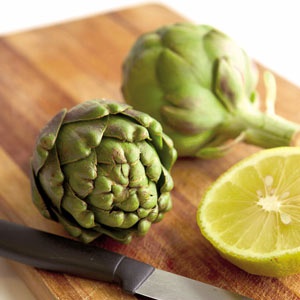Many people simply have no idea how to cook artichokes, others avoid
eating them because of the strange appearance.
But underneath the hard prickles of these funny-looking flowers lies a
heart full of nutritional value and the secret that makes the artichoke
a sought-after culinary delicacy.
Background
The globe or French artichoke, originating from the Mediterranean,
has been around forever and the ancient Egyptians and Romans prized
them for their medicinal properties (see below). Today, in some parts
of the world, artichokes are so highly praised people devote entire
festivals to it. Like in Castroville, California, which is fondly
called the “green globe” capital of the United States. Since 1922 an
annual artichoke festival has been held there and guess who was the
artichoke queen of 1949, a young aspiring actress named Marilyn Monroe.
Choosing
Artichokes are best in summer; choose one that is firm and heavy
with stiff tightly packed leaves. Because the artichoke is a flower
bud, open leaves indicate that it is overripe, and will therefore be
hard and have too large a choke. If you can’t find them fresh, look for
canned, frozen or marinated artichoke hearts that are readily available
in stores. You may also be offered a choice between mature globe
artichokes or younger vegetables (picked while the leaves and choke are
still soft and completely edible).
Cooking
When cooking artichokes, you should first remove the hard,
inedible bits, the fibrous choke in the middle as well as the spines at
the ends of the leaves.
Break the stalk off the artichoke so
that any fibres are pulled out and then trim the base with a knife. The
pointed top of the artichoke should be cut off parallel to the base.
While preparing artichokes, you can cover the cut surface with lemon
juice to prevent it from turning brown.
Cover the artichokes
with cold water, add a drop of oil and bring to the boil. Reduce the
heat and simmer, covered, for about 30 minutes. Drain the artichokes
upside-down to release any water trapped between the leaves. Let the
artichokes cool slightly. Remove the central cone of leaves with a
quick twist and put aside. The fibrous choke can then be scooped out.
Set the central cone of leaves upside down in the artichoke where the
central choke was scooped out. You can fill the cup in the centre of
the leaves with vinaigrette or another sauce for serving. Eat your
artichoke leaf by leaf; the leaves being detached with fingers dipping
the base in a sauce. At formal meals only the hearts are served,
garnished or stuffed. Artichokes have a mild, slightly nutty taste and
are usually served with a rich sauce. Artichokes can also be steamed,
baked, stuffed, fried or cooked in the microwave oven, let our recipes
below guide you.
Health info
Artichokes, especially those with a slightly bitter taste, are
reputed to prevent the build-up of fats in artery walls, thus
protecting against heart disease and high cholesterol. Irritable bowl
syndrome is another complaint that can apparently be eased by eating
globe artichokes, as are bloating, flatulence, abdominal cramps and
constipation. Globe artichokes are also a great addition to a diabetic
diet and for those trying to lose weight. They’re low in kilojoules and
carbohydrates and high in fibre; rich in vitamins and minerals,
especially vitamin A, C, iron and potassium, and are a good source of
protein.
And in case you wondered, the word artichoke is shared by three
unrelated plants; the globe artichoke (described here) as well as the
Jerusalem artichoke and the Chinese (or Japanese) artichoke.
5 things to do with artichokes
Artichokes in Parmesan batter with olive oil and capers
Pizza with shrimps and artichokes
Smoked beef and artichoke quiche

